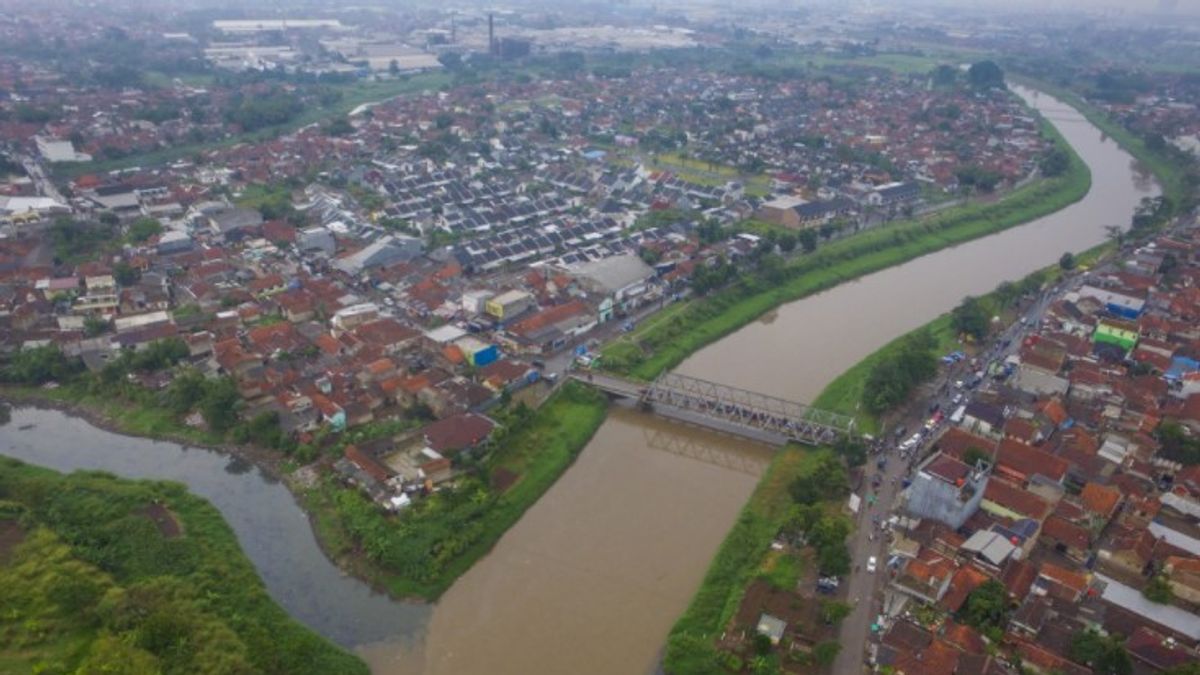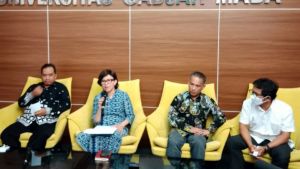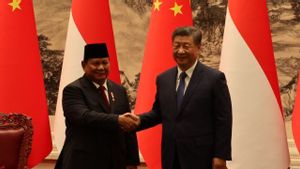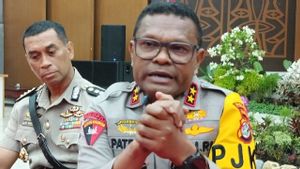JAKARTA - Readers, do you know that Banten, West Java, and DKI Jakarta were once under the rule of the Tarumanegara Kingdom? This information is explained by Deni Prasetya in the book Knowing Islamic Kingdoms. Not only is it the oldest kingdom, but Tarumanegara is also known as a Hindu-style kingdom with the Vishnu sect. Although its glory has lasted a long time, there are several historical remains of the Tarumanegara kingdom that can still be found today.
Tarumanegara Kingdom is estimated to have been founded in the 4th century AD by Rajadirajaguru Jayasingawarman. The kingdom had a large area of power, namely in West Java or Sunda (including Banten and Jakarta).
In the 5th century AD, King Purnawarman succeeded in bringing Tarumanegara to its glorious period. For his services, he is remembered on the inscription and is called the king who succeeded in building a megaproject. One of the major projects made by Purnawarman is infrastructure development on the Citarum River.
The Megaproject of the Raja Purnawarman Citarum River which is eternal to the present day
Do you still remember the legend of Sangkuriang? The story became folklore which indirectly followed the history of the development of the Citarum River.
It is said that Sangkuriang killed Tumang, the dog who was loved by his family. Without realizing it, Tumang is the incarnation of the god as well as the father of Sangkuriang. Because of the tragedy, the mother was furious with her child and hit Sangkuriang with a rice bowl on Sangkuriang's head until he was injured. Due to his mother's harsh treatment, angry and disappointed Sangkuriang decided to run away from home.
Long story short, Sangkuriang, who had been wandering for years, suddenly missed his hometown. Sangkuriang went to the village where he spent his childhood. At that time he met a beautiful woman who made him fall in love, the Dayang Sumbi. What was unexpected, the woman who managed to win Sangkuriang's heart turned out to be his mother.
Dayang Sumbi, who knew that the man who proposed to her was none other than her son, tried to put forward two conditions in the hope of thwarting Sangkuriang's proposal.
The first condition is damming the river and the second condition is to build a big boat to cross the river. Both conditions must be fulfilled within one night. Of course, by all means, Dayang Sumbi tried to thwart Sangkuriang's efforts. In the end, Dayang Sumbi's attempt to do away with Sangkuriang's effort was successful.
Disappointed, Sangkuriang kicked the boat which was later believed to be the origin of Tangkuban Parahu. Sangkuriang also damaged the river that he was damaging to become the forerunner of the Citarum River.
The word "Citarum" comes from two words, "Ci" and "Tarum". "Ci" or "Cai" in Sundanese means water. Meanwhile, "Tarum" is a type of plant that produces purple or indigo. Usually used for traditional textile dyes.
In the citarum.org site, it is stated that the river which has its head at Mount Wayang, Bandung Regency, is the longest and largest river in West Java Province. The length of the river flows up to 297 Km and almost stretches West Java.
The source of Citarum water comes from the spring of Mount Wayang (south of Bandung City) which then flows north through the Bandung Basin and empties into the Java Sea.
In the Wangsakerta manuscript, as quoted from indonesia.go.id website, it is said that during the reign of Sri Maharaja Purnawarman, the third king of Tarumanegara built a giant project from the 3rd of Jesta (May/June) to the 12th of Asada (June/July) year 419 in Citarum.
Purnawarman ordered dredging and deepening of the Citarum River for irrigation and flood control. The Citarum River itself is dredged from the Bandung Basin, a basin surrounded by volcanoes with a height of 650 meters above sea level to more than 2000 meters above sea level.
Seven Inscription Relics of the Tarumanegara Kingdom
The size of the Tarumanegara Kingdom is indeed told in the inscriptions that have been researched by historians and archaeologists. In fact, Tarumanegara itself has seven inscriptions that tell the size of their kingdom and tell the services of Purnawarman, the king who succeeded in building a big project. Then, what are the relics of the Tarumanegara inscription?
Ciaruteun Inscription
It is located in the Leuwiliang area, Bogor. In the inscription depicted a pair of feet with the information that these feet belonged to King Purnawarman. Apart from the soles of the feet are also depicted spiders and circular curly letters.
"The two feet of King Purnawarman, the king of Taruma, the brave king," reads the inscription.
In addition, there are also paintings of spiders and circular curly letters. There are several opinions that say that the letter is the signature of King Purnawarman.
Guava Inscription
As the name suggests, this inscription was found in a guava plantation on the Koleyangkak Sand dunes, Leuwiliang, Bogor (30 km West of Bogor). The inscription also contains information related to Purnawarman's footprint.
"These footprints are the footprints of Sri Purnawarman, the king of Tarumanegara. The high Majesty is well-known, brave, honest, and loyal in carrying out his duties and is matchless. The high Majesty has always succeeded in destroying his enemies. The high Majesty respects the princes but is greatly feared by his enemies, and protects those who provide assistance to him.
Pasir Awi Inscription
This inscription was found in Pasir Awi, Bogor. In the cultural site.kemdikbud.go.id, it is said that an archaeologist from the Netherlands, N.W. Hoepermans discovered the inscription for the first time in 1864.
In the inscription carved a pair of the same footprints as the one in the Jambu inscription. This means that the image of the footprint is likely to be considered to be the footprint of Sri Purnawarman.
Kebun Kopi Inscription
Found in Muara Hilir village, Cibungbulan Bogor. Like other inscriptions, the soles of the feet are also engraved on the rock face. In the inscription it is written, "the soles of the feet are like the feet of tears. Airawata is the elephant vehicle of Indra. These are the feet of the ruler of the great Taruma state”.
Muara Cianten Inscription
Found in Muara Cianten, Bogor. In this inscription, again found an image which is considered the sole of Purnawarman's feet. Unfortunately, until now the inscriptions cannot be read. This inscription was first reported by N.W. Hoepermans in 1864.
Tugu Inscription
Found in Tugu, Cilincing area, DKI Jakarta (adjacent to the border with Bekasi). On the surface of the inscription tells the depiction of Purnamarwan.
"Previously, the river named Candra Hhaga was (ordered) to be dug by Maharaja Purnamarwan. The noble Maharaja has strong arms. After arriving at the famous royal palace, the river was poured out into the sea. In the 22nd year of the glorious throne king Purnawarman, who shone with intelligence and wisdom and became the standard of all kings. His Majesty also ordered to dig a beautiful, clear river called Gomati after the river flowed in the noble residence of Grandma the priest (the Purnawarman). This work was started on a good day on the 8th half of the evening of the month of Phalguna and was finished on the 13th half of the light of the month of Caitra, it was only 21 days while the excavation was 6122 long. The ceremony (salvation) was performed by the Brahmins accompanied by 1000 cows to be sacrificed."
Lebak Or Cidanghiang Inscription
Found in Lebak village which is located on the banks of the Cidanghiang river, Muncul sub-district, Pandeglang District, Banten. This inscription first appeared in the report of the head of the Antiquities Service Toebagoes Roesjan in 1947.
This inscription is also often referred to as the Cidanghiang inscription or the Munjul inscription. This inscription also tells the figure of Purnawarman.
"This is a sign of nobility of Purnawarman. You are a great and brave king. You are the king of the world and become the banner of all kings."
The Lebak inscription also tells about the boundaries of the Tarumanegara kingdom, which in the west is bordered by the sea, in the south by the sea, in the east by the Citarum River, and in the north by Karawang.
Apart from the historical relics of the Tarumanegara Kingdom, get information and other national and international news through VOI.
The English, Chinese, Japanese, Arabic, and French versions are automatically generated by the AI. So there may still be inaccuracies in translating, please always see Indonesian as our main language. (system supported by DigitalSiber.id)












